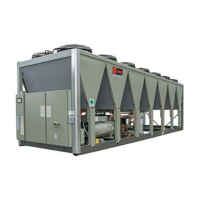40
CG-SVX039C-GB
Evaporator Piping
A typical CGAF / CXAF evaporator piping
instrumentation is shown below.
Figure 4 – Unit typical water circuit
1 = Pressure gauges: shows entering and leaving water
pressure
2 = Balancing valve: adjusts water flow.
3 = Air purge allows to remove the air from the water
circuit during fill up.
4 = Stop valves: isolate chillers and water circuiting
pump during maintenance operations.
5 = Thermometers: indicate chilled water entering and
leaving temperatures.
6 = Expansion compensators: avoid mechanical stress
between chiller and piping installation.
7 = Stop valve located on the outlet connection: used
to measure the water pressure inlet or outlet of
evaporator.
8 = Strainer: avoid to get heat exchangers dirty. All
installation must be equipped with efficient strainer
in order that only clean water enters into exchanger.
If there is no strainer, reserve will be formulated by
the Trane technician at the start-up of the unit. The
trainer used must be able to stop all particles with a
diameter greater than 1 mm.
9 = Draining: used as the draining the plate heat
exchanger.
10 = Do not start the unit with low water volume or not
enough pressurized circuit.
Note: A pressure switch device to detect lack of water
is not included in the pump package. Installation of this
type of device is highly recommended to avoid sealing
damage due to operation of pump without enough
water.
An air vent is located on top of the evaporator at the
chiller water outlet. Be sure to provide additional air
vents at the highest points in the piping to remove air
from the chilled water system. Install necessary pressure
gauges to monitor the entering and leaving chilled water
pressure.
Provide shut off valves in lines to the gauges to isolate
them from the system when they are not in use. Use
rubber vibration eliminators to prevent vibration
transmission through the water lines.
If desired, install thermometers in the lines to monitor
entering and leaving water temperatures.
Install a balancing valve in the leaving water line to
control water flow balance.
Install shut-off valves on both the entering and leaving
water lines so that the evaporator can be isolated for
service.
It is mandatory to place a flow switch device at the outlet
of the unit and to link it with the control of the unit (see
wiring diagrams shipped with the unit).
CAUTION! The chilled water connections to the
evaporator are to be “grooved pipe” type connections.
Do not attempt to weld these connections, because the
heat generated from welding can cause microscopic and
macroscopic fractures on the heat exchanger connection
that can lead to premature failure of the connection. An
optional grooved pipe stub and coupling should be used
for welding on flanges.
To prevent damage to chilled water components, do not
allow evaporator pressure (maximum working pressure)
to exceed 10 Bar. The maximum service pressure
depends on free-cooling type and potential pump
package option. The value of max service pressure is
indicated on unit nameplate.
Entering Chilled Water Piping
• Air vents to bleed the air from the system (to be placed
on the highest point)
• Water pressure gauges with shut-off valves
• Vibration eliminators
• Shut-off (isolation) valves
• Thermometers if desired (temperature readings
available on chiller controller display)
• Clean-out tees
• Pipe strainer
Leaving Chilled Water Piping
• Air vents to bleed the air from the system (to be placed
on the highest point)
• Water pressure gauges with shut off valves
• Vibration eliminators
• Shut-off (isolation) valves
• Thermometers (temperature readings available on the
chiller controller display)
• Clean-out tees
• Balancing valve
• Flow Proving Device
Pressure Gauges
Install field-supplied pressure components. Locate
pressure gauges or taps in a straight run of pipe; avoid
placing them near elbow (at least at 10 pipe diameter
from discontinuity).
To read manifold pressure gauges, open one valve and
close the other (depending on the side of the desired
reading), this eliminate errors resulting from differently
calibrated gauges installed at unmatched elevations.

